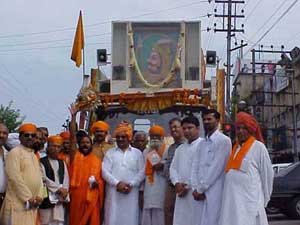Found some more new pics....😊
Quila Rai Pithora-
The Tomars ruled for almost a century till the Chauhan Rajputs conquered Delhi. Prithviraj Chauhan massive ramparts around the area and renamed Lal Kot as Quila Rai Pithora. The Chauhans ruled till the end of the twelveth century when the legendary Prithvi Raj Chauhan was defeated and killed by Mohammed Ghor, the Turkish invader in 1192. Prithviraj Chauhan, the last Hindu ruler of Delhi. Ghor returned to Afghanistan after installing his trusted slave Qutab ud din Aibak as General in charge of Delhi. Qutb ud din Aibak built India 's first mosque Quwwatul Islam Masjid at this site. It is said that many of the pillars are from the Hindu and Jain temples that stood within the city of Rai Pithora. The mosque was completed in 1198. One attractive feature of the mosque is the sandstone screen that forms the faade of the mosque. It is carved in a fusion of Hindu and Islamic styles.
Accusing the Central government of backing out from bringing back mortal remains of Prithvi Raj Chauhan from Ghazni in Afghanistan, Partap Jyoti Yatra leaders here today, alleged that no effort was being made to bring back mortal remains of the great patriot despite end of Taliban rule in Afghanistan.
Activists of Partap Jyoti Yatra, which reached Jalandhar on Saturday, in front of their "rath" before the start of the next leg of the yatra. — Photo by S.S. Chopra
(I'm glad to read this personally!😊)
Prithviraj Chauhan
Prithviraj Chauhan was the king of Delhi. His capitals were at Delhi and Ajmer. A brave and valiant warrior king, he is revered for his bravery and endearment to subjects. His fort in Delhi known as Rai Pithora is now being excavated and can be seen in South Delhi. He is reputed to be able to shoot arrows with accuracy on hearing just a sound. He resisted 16 times attacks by the afghan warlord Mohammed ghori but released him every time. The 17th time Ghori won but unlike Chauhan he captured him and blinded him. He was then caged and carried to Afghanistan like an animal.
Folklore has it how he got married by valiantly carrying off his beloved all alone from her palace with many kings being present but none could match the swordmanship of Chauhan.(Aww....I love this!😳)
Folklore also says how Ghori wanted to test Chauhan's ability to shoot at sound source and he was asked to do so in the court of Ghori. Also present was his lifelong friend and poet – Chandbardai. Chandbardai wanted to say a poem before his king would shoot. In this poem Chandbardai cleverly indicated the exact location of Ghori to the blind Prithviraj Chauhan. Chauhan shot his arrow – not at the source of the sound but at Ghori and killed him. His mortal remains are still in Afghanistan.
Haveli Braj Bhushanjee, (Heritage Hotel)
In 1193 AD when Prithvi Raj Chauhan was defeated by Sultan Mohammed Gauri, some Chauhan nobles seeked shelter in Mewar and became allied to the Rana while other young warriors moved towards the Chambal valley and overpowered the Meena and Bhil tribals - thus establishing their own kingdom of Hadoti.
Taragarh Fort-
36 km from Kota is a tiny picturesque town, Bundi - One of the unexplored cities with a rich historical wealth. Once a part of Kota, it was ruled by the Had Chauhans - an offshoot of the famous Chauhan clan who ruled Delhi and Ajmer. Bundi is surrounded by the Aravalli hills on the three sides and is circumscribed by a massive wall with four gateways. In 1193 AD when Prithvi Raj Chauhan was defeated by Sultan Mohammed Ghauri, some Chauhan nobles seeked shelter in Mewar and became allies to the Rana while other young warriors moved towards the Chambal valley and overpowered the Meena and Bhil tribals thus establishing their own kingdom of Hadoti. Later, two branches of Hadas formed two separate states of Kota and Bundi, on either side of the River Chambal. Bundi is surrounded by the Aravalli hills on three sides and is circumscribed by a massive wall with four gateways.
Visit the TARAGARH or STAR FORT. Perched on a thickly wooded hill is a marvelous white fort with a huge reservoir that once supplied water to the palace. Built in 1354 AD the fort is one of the most impressive forts of Rajasthan. This magnificent edifice is a fine example of the Rajput architecture, housing some of the superb Bundi murals.
The Land of Composite Culture
Ajmer situated in the green oasis wrapped in the barren hills has been a witness to an interesting past. The city was founded by Raja Ajay Pal Chauhan in the 7th Century A.D. and continued to be a major center of the Chauhan power till 1193 A.D,. when Prithviraj Chauhan lost it to Mohammed Ghauri. Since then, Ajmer became home to many dynasties, which came and left leaving behind incredible marks of their culture and traditions on the city's history, converting it to an melting point of various cultures and blend of Hinduism and Islam. Today, Ajmer is a popular pilgrimage center for the Hindus as well as Muslims. Especially famous is the Dargah Sharif-tomb of the Sufi saint Khwaja Moinuddin Chisti,which is equally revered by the Hindus and Muslims.
Hope u lyk dem!😳
Reeti




























